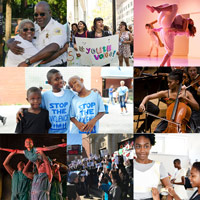The Arts & Culture Loan Fund helps nonprofits stabilize their finances, build financial expertise through training, and take advantage of new opportunities.

Malik Gillani beamed with pride over the holiday season as the cast of his theater and media arts company presented “Christmas Mubarak,” an interfaith musical focused on the prominent role of Jesus in the Quran.
But it was not always so cheery for his Silk Road Rising nonprofit. Up-and-down cash cycles threatened the group’s existence until Gillani methodically built a financial cushion over the last decade, thanks in part to a loan program that helps educate arts organizations in better management.
“We had months where we had to go without salary,” he explained. “We had to call on donors and board members to say, ‘Can you float us money?’”

Photos of Silk Road Rising production of "Christmas Mubarak" by Airan Wright
Like many new businesses, nonprofit arts organizations are particularly vulnerable to failure in their early stages. Irregular sources of income and a lack of cash reserves can jeopardize their ability to sustain operations. Often their financial prospects are considered too risky for traditional bank loans, as banks require assurances the funds will be repaid.
The Arts & Culture Loan Fund was established by the MacArthur Foundation in 2009 to help nonprofits like Silk Road Rising meet short-term cash needs through access to working capital loans, improve financial management skills, and build credit histories to meet future financing needs.
The fund has assisted 36 small- to mid-size Chicago organizations with budgets from $250,000 to $5 million. The program has offered an average credit line of $68,000 to nonprofits, helping them build credit history.
Building ‘Financial Muscle’
An evaluation of the program in 2015 found that receiving a loan helped many participants maintain stability and programming levels and even consider artistic risks. More than 60 percent reported that the program helped them pay bills and manage the seasonality of their work.
For others, the loan was still not enough to keep them afloat. Some defaulted or ceased to operate.
IFF, a Community Development Financial Institution, originally served as both coordinator of the grant and a lender in the program. FMA, a financial management consulting service that currently administers the program, was brought in to offer counseling and workshops for nonprofit staff and boards. Hilda Polanco, FMA’s founder and chief executive, said her service aspires to hone the skills and knowledge of nonprofit leaders.
The work is aimed at building “the financial muscle of both individuals and teams to be able to make the best choices they can with the limited resources they have,” she explained.
Making a Game Plan
About eight years ago, Silk Road Rising received $75,000 from the fund. At the time, its budget was around $400,000, but it has since grown to nearly $800,000. It now employs more artists and has expanded its offerings and arts learning programs.
Gillani says the additional resources and financial coaching helped his organization make better decisions and focus on the bigger picture of reaching its goals.
“What this cash allows us to do is to know that we have the time to make a game plan,” he said.
The mission of his nonprofit is to promote multicultural understanding and shape conversations about Asian and Middle Eastern Americans through storytelling and dialogue.
In a creative deal, Silk Road Rising presents six theatrical programs a year for tenants of the building where it has offices in exchange for rent-free space. It staged its interfaith “Christmas Mubarak” production at its theater venue in downtown Chicago, adding free performances in the lobby of its office building.
Challenge Becomes Opportunity

Caroline Older
Another nonprofit facing a tough business challenge was the Chicago Artists Coalition (CAC). However, executive director Caroline Older says it turned the situation into a valuable opportunity.
CAC supports artists and curators by offering residency programs, exhibitions, professional development and resources that enable them to stay and thrive in Chicago.
After seven years in the West Loop, CAC’s landlord was selling the building where it was located, and rising rents made it difficult to find affordable space nearby. Moving further west to a loft-style building proved to be the best option for replicating its galleries, artist studios, and education center.
Older says a line of credit from the Arts & Culture Loan Fund and four FMA training sessions helped CAC smooth out its cash flow. Meanwhile, it is on track to repay its loan on time and is raising more funds through a capital campaign to pay for a build-out at its new location.
“For an organization with an annual budget of less than $1 million to move and to build out a new space is a significant financial undertaking,” said Older, adding that without the loan fund, “it would have been incredibly difficult for us to do.”

Since 2009, 36 arts organizations have received $2.55 million in loans through MacArthur’s Arts & Culture Loan Fund.






